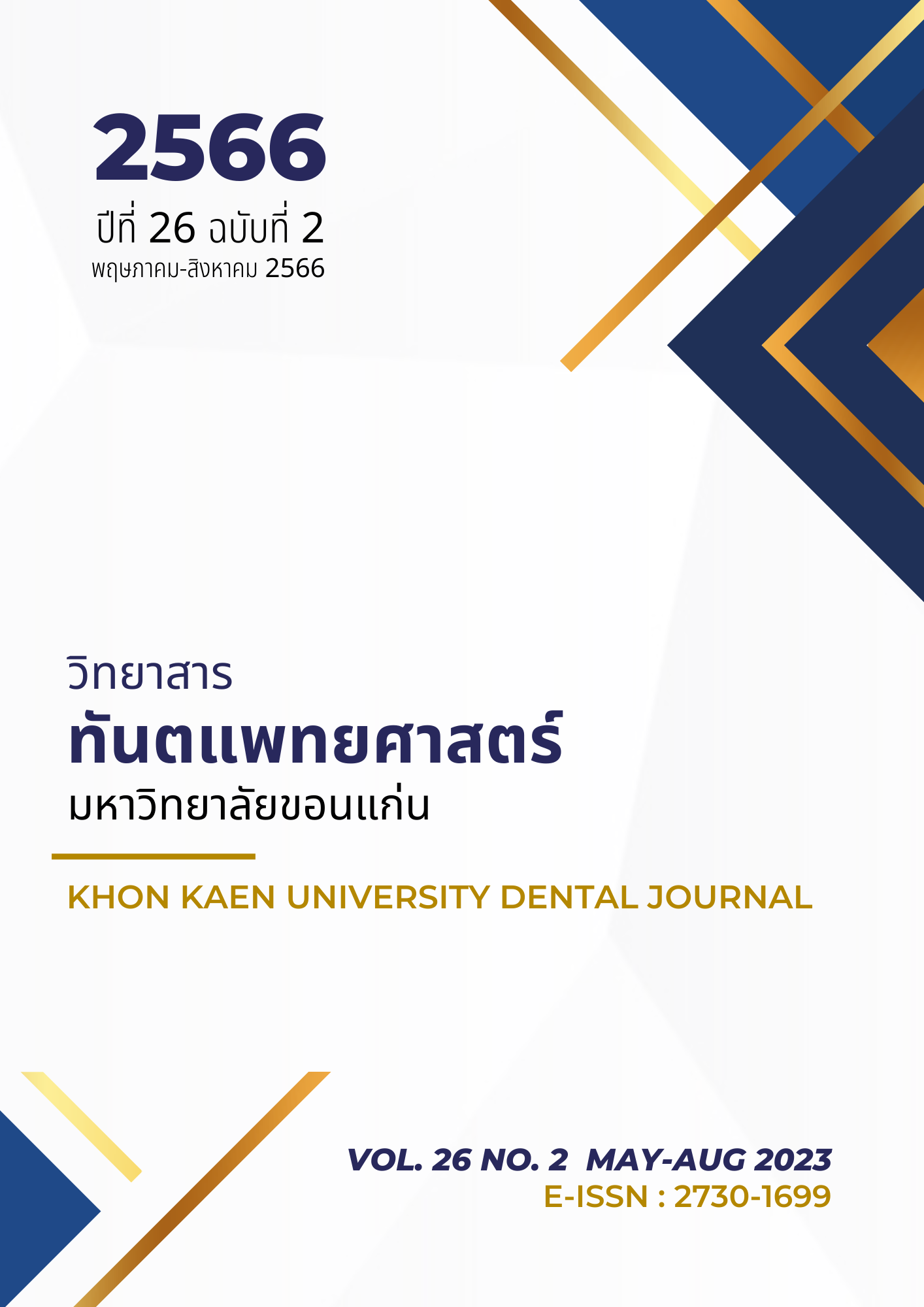Effect of 1450 ppm Fluoride Toothpaste in Remineralization of Incipient Carious Lesions: An In Vitro Study
Main Article Content
Abstract
The aim of this study was to compare the remineralization effect of 1000 and 1450 ppm fluoride toothpaste on artificial enamel carious lesion. Thirty enamel specimens with artificial carious lesions were randomly assigned into 3 groups: 1) artificial saliva 2) 1000 ppm fluoride toothpaste 3) 1450 ppm fluoride toothpaste. The specimens were subject to 14-day pH cycling, the treatment groups were immersed in fluoride toothpaste solution for 2 minutes twice a day during the pH cycling phase. The percentage of fluorescence loss ( F) was measured using the quantitative light-induced fluorescence-digital machine (QLF-D). The change of percentage of fluorescence loss ( F) was determined. The results showed that F in fluoride toothpaste groups were significantly greater than in the control group. The 1450 ppm fluoride toothpaste group showed significantly higher F compared to 1000 ppm fluoride toothpaste group (p=0.042). In conclusion, the results from this study demonstrated that the use of 1450 ppm fluoride toothpaste significantly increased remineralization of artificial enamel carious lesions than the use of 1000 ppm fluoride toothpaste.
Article Details

This work is licensed under a Creative Commons Attribution-NonCommercial-NoDerivatives 4.0 International License.
บทความ ข้อมูล เนื้อหา รูปภาพ ฯลฯ ที่ได้รับการลงตีพิมพ์ในวิทยาสารทันตแพทยศาสตร์ มหาวิทยาลัยขอนแก่นถือเป็นลิขสิทธิ์เฉพาะของคณะทันตแพทยศาสตร์ มหาวิทยาลัยขอนแก่น หากบุคคลหรือหน่วยงานใดต้องการนำทั้งหมดหรือส่วนหนึ่งส่วนใดไปเผยแพร่ต่อหรือเพื่อกระทำการใด ๆ จะต้องได้รับอนุญาตเป็นลายลักษณ์อักษร จากคณะทันตแพทยศาสตร์ มหาวิทยาลัยขอนแก่นก่อนเท่านั้น
References
The 8th National Oral Health Survey in Thailand [Internet]. Dental Health Division, Department of Health, Ministry of Public Health. 2017. Available from: https://dental.anamai.moph.go.th/web-upload/migrated/files/dental2/n2424_765046ad86a54985537887456d464d2f_surveu_8th_2nd.pdf.
Juntave A. Altrnative Approaches in pediatric dental caries management. J Dent Assoc Thai 2017;67(3):179-88.
Guidline on Fluoride Therapy in children [Internet]. The Dental Association Of Thailand. 2017. Available from:https://www.thaidental. or.th/main/download/ upload/upload-2019021 3213340.pdf.
Trairatvorakul C. Preventive dentistry in child and adolescence. 2ed. Bangkok: Department of pediatric dentistry, faculty of dentistry, Chulalongkorn University;2008.235-40.
Walsh T, Worthington HV, Glenny AM, Appelbe P, Marinho VC, Shi X. Fluoride toothpastes of different concentrations for preventing dental caries in children and adolescents. Cochrane Database Syst Rev 2010(1):Cd007868.
Marinho VC, Higgins JP, Sheiham A, Logan S. Fluoride toothpastes for preventing dental caries in children and adolescents. Cochrane Database Syst Rev 2003;2003(1):Cd002278.
Twetman S, Axelsson S, Dahlgren H, Holm AK, Källestål C, Lagerlöf F, et al. Caries-preventive effect of fluoride toothpaste: a systematic review. Acta Odontol Scand 2003;61(6):347-55.
Conti AJ, Lotzkar S, Daley R, Cancro L, Marks RG, McNeal DR. A 3-year clinical trial to compare efficacy of dentifrices containing 1.14% and 0.76% sodium monofluorophosphate. Community Dent Oral Epidemiol 1988;16(3):135-8.
O'Mullane DM, Kavanagh D, Ellwood RP, Chesters RK, Schafer F, Huntington E, et al. A three-year clinical trial of a combination of trimetaphosphate and sodium fluoride in silica toothpastes. J Dent Res 1997;76(11):1776-81.
Hellwig E, Altenburger M, Attin T, Lussi A, Buchalla W. Remineralization of initial carious lesions in deciduous enamel after application of dentifrices of different fluoride concentrations. Clin Oral Investig 2010;14(3):265-9.
Hatipoglu Z, Yavlal GO, Yavlal O. Effects of different fluoride-containing toothpastes on in vitro enamel remineralization. Bezmialem Sci 2019;7(1):12-7.
Manosubsak N, Sukarawan W, Sriarj W. The remineralization quality by fluoridated dentifrice on artificial incipient caries lesion. M Dent J 2019;39(1): 53-62.
Gomez J. Detection and diagnosis of the early caries lesion. BMC Oral Health 2015;15 Suppl 1(Suppl 1):S3.
van der Veen MH, de Josselin de Jong E. Application of quantitative light-induced fluorescence for assessing early caries lesions. Monogr Oral Sci 2000;17:144-62.
Lynch RJ. The primary and mixed dentition, post-eruptive enamel maturation and dental caries: a review. Int Dent J 2013;63 Suppl 2(Suppl 2):3-13.
Speirs RL. The nature of surface enamel in human teeth. Calcif Tissue Res 1971;8(1):1-16.
Alsaffar A, Tantbirojn D, Versluis A, Beiraghi. B. Protective effect of pit and fissure sealants on demineralization of adjacent enamel. Pediatr Dent 2011;33(7):491-5.
Rana R, Itthagarun A, King NM. Effects of dentifrices on artificial caries like lesions: an in vitro pH cycling study. Int Dent J 2007;57(4):243-8.
Application of QLFTM for Diagnosis and Quality Assessment in Clinical Practice [Internet]. Inspektor Research Systems: Amsterdam, The Netherlands. 2012. Available from: http://www.inspektor.nl/ download/ WhitepaperQLF-11.pdf.
Gomez J, Pretty IA, Santarpia RP, 3rd, Cantore B, Rege A, Petrou I, et al. Quantitative light-induced fluorescence to measure enamel remineralization in vitro. Caries Res 2014;48(3):223-7.
Oliveira GM, Ritter AV, Heymann HO, Swift E, Jr., Donovan T, Brock G, et al. Remineralization effect of CPP-ACP and fluoride for white spot lesions in vitro. J Dent 2014;42(12):1592-602.
Buzalaf MA, Hannas AR, Magalhães AC, Rios D, Honório HM, Delbem AC. pH-cycling models for in vitro evaluation of the efficacy of fluoridated dentifrices for caries control: strengths and limitations. J Appl Oral Sci 2010;18(4):316-34.
Itthagarun A, Wei SH, Wefel JS. The effect of different commercial dentifrices on enamel lesion progression: an in vitro pH-cycling study. Int Dent J 2000;50(1):21-8.
ten Cate JM, Duijsters PP. Alternating demineralization and remineralization of artificial enamel lesions. Caries Res 1982;16(3):201-10.
Blinkhorn AS, Holloway PJ, Davies TG. Combined effects of a fluoride dentifrice and mouthrinse on the incidence of dental caries. Community Dent Oral Epidemiol 1983;11(1):7-11.
Ganss C, Marten J, Hara AT, Schlueter N. Toothpastes and enamel erosion/abrasion - Impact of active ingredients and the particulate fraction. J Dent 2016;54:62-7.
Wang LJ, Tang R, Bonstein T, Bush P, Nancollas GH. Enamel demineralization in primary and permanent teeth. J Dent Res 2006;85(4):359-63.
Ando M, van Der Veen MH, Schemehorn BR, Stookey GK. Comparative study to quantify demineralized enamel in deciduous and permanent teeth using laser- and light-induced fluorescence techniques. Caries Res 2001; 35(6): 464-70.
Gouvêa DB, Santos NMD, Pessan JP, Jardim JJ, Rodrigues JA. Enamel subsurface caries-like lesions induced in human teeth by different solutions: a TMR analysis. Braz Dent J 2020;31(2): 157-63.
Davies RM, Ellwood RP, Davies GM. The rational use of fluoride toothpaste. Int J Dent Hyg 2003; 1(1):3-8.
Mascarenhas AK, Burt BA. Fluorosis risk from early exposure to fluoride toothpaste. Community Dent Oral Epidemiol 1998;26(4):241-8.
Bentley EM, Ellwood RP, Davies RM. Fluoride ingestion from toothpaste by young children. Br Dent J 1999;186(9):460-2.


